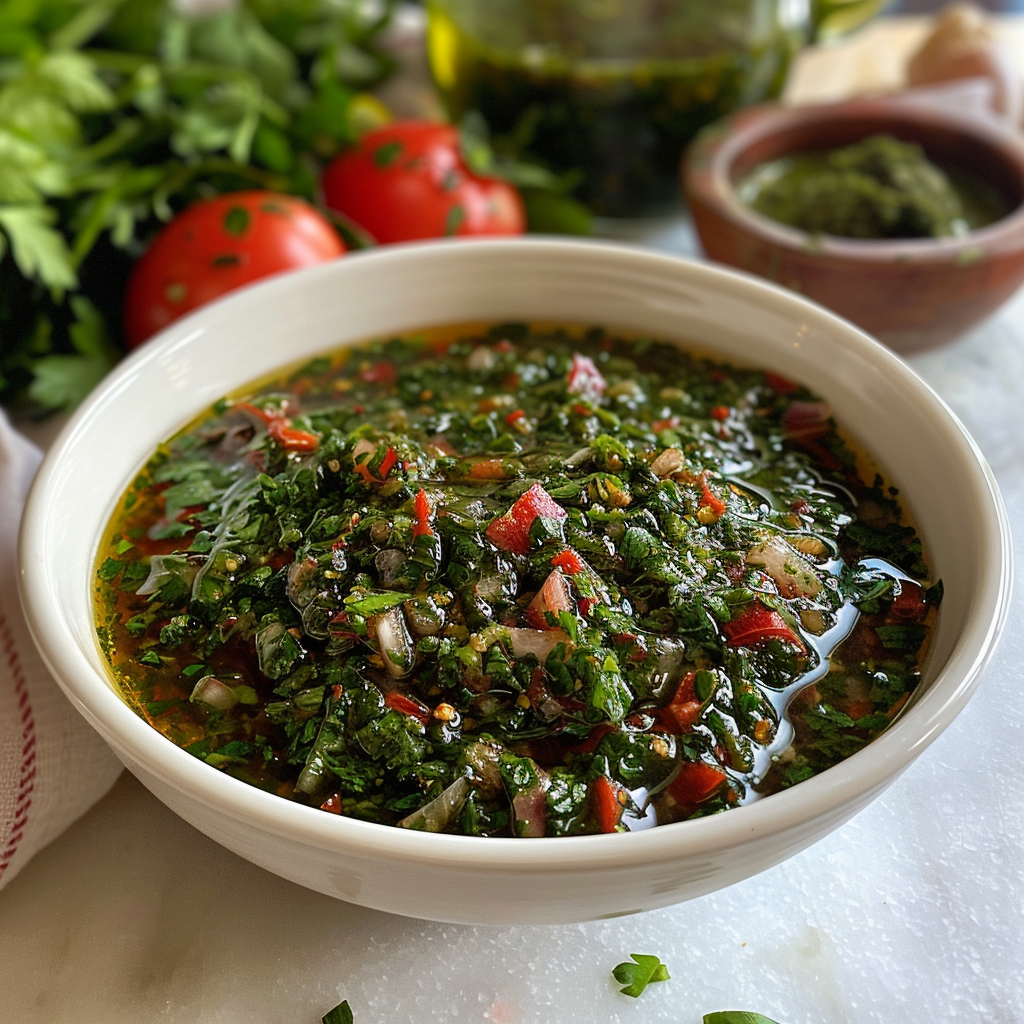Hey there, it’s Jacob Allen from Beyond the Bayou Blog. Today, I’m thrilled to share a dish that’s close to my heart and always brings me back to simpler times—Chimichurri Sauce. It’s more than just a recipe; it’s a journey through fond memories of shared meals and laughter-filled gatherings.
Back in my college days, while scrolling through food magazine for inspiration, I stumbled upon a tantalizing recipe for chimichurri sauce. Intrigued by its simplicity and bold flavors, I decided to give it a try. With just a handful of ingredients and no cooking required, it seemed like the perfect dish for a busy student like myself.
Gathering my friends in our cozy apartment kitchen, we embarked on a culinary adventure, chopping parsley, mincing garlic, and mixing up the vibrant sauce. As we tasted our creation, we were blown away by its fresh and tangy flavors, instantly transported to the streets of Buenos Aires.
From that moment on, chimichurri became a staple in our cooking repertoire, adding a burst of flavor to everything from grilled steaks to simple salads. It wasn’t just a sauce; it was a symbol of friendship and the joy of discovering new flavors together.
Overview: How to Make Chimichurri Recipe?

Chimichurri is a zesty and versatile sauce hailing from Argentina, bursting with fresh flavors that elevate any dish. It’s incredibly easy to make and requires just a handful of simple ingredients that you probably already have in your kitchen. Picture this: vibrant parsley, pungent garlic, and fragrant oregano all coming together with olive oil, red wine vinegar, and a hint of heat from crushed red pepper flakes. It’s a symphony of flavors that adds a punch to grilled meats, roasted vegetables, or even a simple slice of bread.
To whip up a batch of chimichurri, gather your ingredients and equipment. You’ll need a cutting board, knife, mixing bowl, and measuring cups and spoons. Then, finely chop the parsley, garlic, and oregano before mixing them with olive oil, red wine vinegar, and crushed red pepper flakes. Season with salt and pepper to taste, and let the flavors meld together for at least 30 minutes before serving.
Each serving of chimichurri packs a punch of flavor without weighing you down. With just 120 calories per serving and no added sugars, it’s a guilt-free way to jazz up your meals. Plus, it’s versatile enough to accompany a variety of dishes, whether you’re grilling up steaks for a barbecue or simply drizzling it over roasted vegetables for a quick and delicious side. So next time you’re looking to add some excitement to your plate, reach for the chimichurri and let your taste buds dance!
Chimichurri Recipe
Equipment
- Cutting Board
- Knife
- Mixing Bowl
- Measuring Cups
- Spoons
Ingredients
- 1 cup packed fresh parsley leaves
- 3-4 cloves garlic minced
- 2 tbps fresh oregano leaves
- 1/2 cup olive oil
- 2 tbps red wine vinegar
- 1 tsp crushed red pepper flakes
- Salt and black pepper
Instructions
- Finely chop the parsley, garlic, and oregano and place them in a bowl.
- Add the olive oil, red wine vinegar, crushed red pepper flakes, salt, and black pepper to the bowl.
- Mix everything together until well combined.
- Let the chimichurri sit at room temperature for at least 30 minutes before serving to allow the flavors to meld together.
- Use it as a marinade for grilled meats, a sauce for roasted vegetables, or a condiment for sandwiches and empanadas. Enjoy!
Notes
- For a milder flavor, you can remove the seeds from the red pepper flakes or reduce the amount used.
- Feel free to customize the herbs and spices to suit your taste preferences.
Nutrition
My 3 Personal Tips For Chimichurri Recipe
Tip 1: When making chimichurri, don’t be afraid to customize the recipe to suit your taste preferences. Experiment with different herbs and spices to create your own unique flavor profile. Adding a splash of citrus juice or a dash of smoked paprika can take your chimichurri to the next level!
Tip 2: To save time on busy weeknights, consider making a double or triple batch of chimichurri and freezing it in smaller portions. This way, you’ll always have a flavorful sauce on hand to elevate any meal, whether it’s grilled meats, roasted vegetables, or even scrambled eggs.
Tip 3: For an extra burst of freshness, try adding a handful of fresh cilantro or mint to your chimichurri. The additional herbs will add complexity to the sauce and brighten up any dish you serve it with. Plus, it’s a great way to use up any leftover herbs you have in your fridge.
Can I use dried herbs instead of fresh for chimichurri sauce?
While fresh herbs are preferred for chimichurri sauce to achieve that vibrant flavor, you can definitely use dried herbs in a pinch. Just remember to adjust the quantities, as dried herbs are more concentrated in flavor.
What To Serve With Chimichurri Recipe?
Is chimichurri sauce spicy?

It can be, depending on how much crushed red pepper flakes you add. Personally, I like to add just a touch for a subtle kick, but you can adjust the amount to suit your taste preferences. It’s all about finding the perfect balance of flavors for you.
Can I freeze chimichurri sauce?
Absolutely! I often make a big batch of chimichurri and freeze it in ice cube trays for easy portioning. Once frozen, I transfer the cubes to a freezer bag for longer storage. Just remember to thaw it in the fridge overnight before using it.
Bonus Pointers:-
1. For the perfect chimichurri, red wine vinegar is top-notch. If you’re out of it, lemon juice makes a great alternative. We advise against using balsamic or white vinegar for this recipe.
2. To prevent any bitterness in your Argentinian chimichurri, it’s wise to taste-test the parsley beforehand. This way, you can ensure a delightful batch of sauce without any unpleasant surprises.

